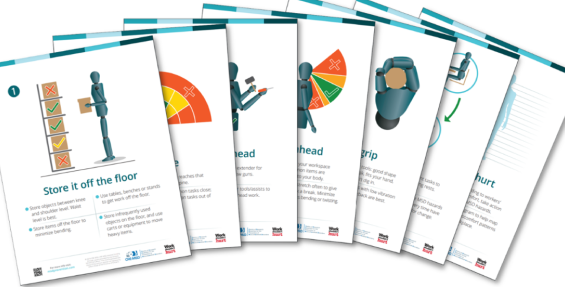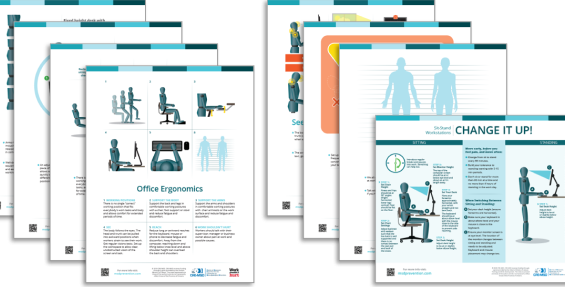
MSD Hazards in the Workplace
A health care professional who treats a person with a work-related MSD will need to outline any limitations to activity. For example, a person with a shoulder strain, may be advised to position their work close to their body between the level of their chest and waist, and to minimize the weight handled. The person with the MSD, their employer, and the WSIB use updates in abilities from health care professionals to identify safe and suitable work.
The MSD Prevention Guideline, and in particular the mini posters in the Quick Start Guide, can be used to educate patients on the workplace hazards that generally increase the rise and re-aggravation of MSD.

Want to search the resource library?
Find all the available resources on the MSD prevention website, including posters, videos, and links to relevant websites.
MSD Guidelines

Quick Start Guide: General
The guide includes a folder and posters that include information on common MSD hazards and solutions to control hazards in many workplaces.

Quick Start Guide: Office
The guide includes a folder and posters that include tips for setting up computer-based workstations and best practices for MSD prevention.
Assessments
Preliminary Assessments
These tools typically contain a list of questions with either yes/no or multiple-choice style responses to note the presence or absence of an MSD hazard and some of its characteristics.
Hazard Controls
The hierarchy of controls is a system developed by the National Institute for Occupational Safety and Health (NIOSH) that ranks hazard controls from most effective (elimination) to least effective (personal protective equipment). Learn more about the Hierarchy of Controls.
Administrative
Changes to the work organization and work practices to reduce exposure to MSD hazards, such as job rotation, pace of work, training, breaks, etc.
Personal Protective Equipment (PPE)
Barriers between the worker and the hazard that are worn by the worker.
Supplementary Guideline Resources
Step 4
Conduct Hazard Identification and Risk Assessments
Step 6
Control Hazards & Implement Changes to Achieve Targets & Goals
Step 8
Evaluate Controls, the Program and the Organization’s Performance
Additional Resources
See All Resources for Healthcare Professionals
View a curated collection of resources in the resource library.



